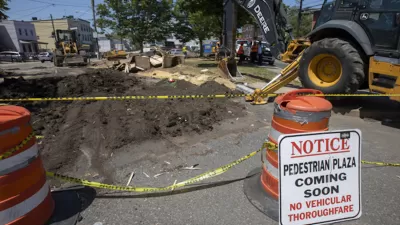The piece begins not in New York but three thousand miles west in Seattle with Janette Sadik-Khan explaining how she triumphed over auto interests by taking back precious road space and returning it to the people in the form of plazas and bike lanes.
Janette Sadik-Khan, New York City Transportation Commissioner under de Blasio's predecessor, Mayor Michael Bloomberg, "gets invited to talk about that work a lot, because a lot of cities around the U.S. want to do what New York did—despite the resistance of the auto-centric status quo," writes Sarah Goodyear for CityLab.
They want to give street space that has been dominated by cars back to people on foot or on bikes. They want public plazas with tables and chairs where people can eat lunch and chat and live their lives. New York’s efforts have become a national model.
"But now, allegedly because of some topless women who get tips by posing for pictures covered only in body paint and some rogue costumed characters, Mayor Bill de Blasio and his police chef, Bill Bratton, are talking about taking the plazas out, or at least re-evaluating them," she adds.
What’s chilling about de Blasio’s and Bratton’s treatment of the situation in Times Square is that it betrays a profound lack of understanding of just how important public space is for people in a dense urban environment such as New York.
Goodyear briefly describes the history of the landmark creation of the Times Square plaza, dating back to Sadik-Khan's 2009 vision, and includes excerpts from an eye-catching array of media coverage, both supporting (New York Daily News) and opposing (New York magazine, The New York Times, Times Square Alliance via POLITICO New York) the conversion of the plaza back to its original form since de Blasio's August 20 announcement.
The battle to reclaim street space from the auto goes far beyond Times Square. Consider signing a petition or two linked in a Streetsblog article if you feel strongly.
FULL STORY: A National Model for Better Streets Is Suddenly at Risk

Maui's Vacation Rental Debate Turns Ugly
Verbal attacks, misinformation campaigns and fistfights plague a high-stakes debate to convert thousands of vacation rentals into long-term housing.

Planetizen Federal Action Tracker
A weekly monitor of how Trump’s orders and actions are impacting planners and planning in America.

San Francisco Suspends Traffic Calming Amidst Record Deaths
Citing “a challenging fiscal landscape,” the city will cease the program on the heels of 42 traffic deaths, including 24 pedestrians.

Defunct Pittsburgh Power Plant to Become Residential Tower
A decommissioned steam heat plant will be redeveloped into almost 100 affordable housing units.

Trump Prompts Restructuring of Transportation Research Board in “Unprecedented Overreach”
The TRB has eliminated more than half of its committees including those focused on climate, equity, and cities.

Amtrak Rolls Out New Orleans to Alabama “Mardi Gras” Train
The new service will operate morning and evening departures between Mobile and New Orleans.
Urban Design for Planners 1: Software Tools
This six-course series explores essential urban design concepts using open source software and equips planners with the tools they need to participate fully in the urban design process.
Planning for Universal Design
Learn the tools for implementing Universal Design in planning regulations.
Heyer Gruel & Associates PA
JM Goldson LLC
Custer County Colorado
City of Camden Redevelopment Agency
City of Astoria
Transportation Research & Education Center (TREC) at Portland State University
Jefferson Parish Government
Camden Redevelopment Agency
City of Claremont



























